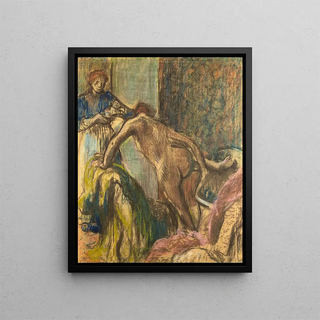Art print | Petit déjeuner après le bain - Edgar Degas Source: Reproduction | Petit déjeuner après le bain - Edgar Degas


View from behind

Frame (optional)
In the vast universe of impressionist art, few works manage to capture the intimacy and delicacy of everyday moments like Edgar Degas's "Petit déjeuner après le bain." This canvas, where sensuality and contemplation intertwine, immerses us in a frozen moment in time—a domestic scene that resonates with emotional depth. Through this piece, Degas invites us to share a moment of life, to observe natural gestures, and to appreciate the beauty of bodies in motion. The soft light and pastel colors create an atmosphere of serenity, making each view of this art print an immersive experience.
Style and uniqueness of the work
"Petit déjeuner après le bain" stands out for how Degas plays with shapes and perspectives. The artist, known for capturing the grace of dancers and scenes of modern life, here transposes his talent to the intimacy of a private space. The female figures, depicted with remarkable finesse, are both elegant and natural. Far from rigid poses, they seem to move within a lively, almost tangible space. The composition, skillfully orchestrated, blends elements of daily life with refined aesthetics, creating a balance between reality and ideal. The gentle tones and subtle contrasts add depth to the work, while the light, filtered through a subdued ambiance, envelops the characters in an aura of tranquility.
The artist and his influence
Edgar Degas, an emblematic figure of the impressionist movement, transcended the conventions of his time by exploring diverse themes ranging from dance to urban life. His academic training, combined with a unique sensitivity to movement and light, allowed him to develop an inimitable style. In "Petit déjeuner après le bain," he reveals a more intimate facet of his art, moving away from ballet scenes to immerse himself in the domestic sphere. This approach not only enriched his repertoire but also influenced many artists who followed. Degas paved the way for a new way of approaching painting, where meticulous observation of daily life becomes a source of inspiration.

Matte finish

View from behind

Frame (optional)
In the vast universe of impressionist art, few works manage to capture the intimacy and delicacy of everyday moments like Edgar Degas's "Petit déjeuner après le bain." This canvas, where sensuality and contemplation intertwine, immerses us in a frozen moment in time—a domestic scene that resonates with emotional depth. Through this piece, Degas invites us to share a moment of life, to observe natural gestures, and to appreciate the beauty of bodies in motion. The soft light and pastel colors create an atmosphere of serenity, making each view of this art print an immersive experience.
Style and uniqueness of the work
"Petit déjeuner après le bain" stands out for how Degas plays with shapes and perspectives. The artist, known for capturing the grace of dancers and scenes of modern life, here transposes his talent to the intimacy of a private space. The female figures, depicted with remarkable finesse, are both elegant and natural. Far from rigid poses, they seem to move within a lively, almost tangible space. The composition, skillfully orchestrated, blends elements of daily life with refined aesthetics, creating a balance between reality and ideal. The gentle tones and subtle contrasts add depth to the work, while the light, filtered through a subdued ambiance, envelops the characters in an aura of tranquility.
The artist and his influence
Edgar Degas, an emblematic figure of the impressionist movement, transcended the conventions of his time by exploring diverse themes ranging from dance to urban life. His academic training, combined with a unique sensitivity to movement and light, allowed him to develop an inimitable style. In "Petit déjeuner après le bain," he reveals a more intimate facet of his art, moving away from ballet scenes to immerse himself in the domestic sphere. This approach not only enriched his repertoire but also influenced many artists who followed. Degas paved the way for a new way of approaching painting, where meticulous observation of daily life becomes a source of inspiration.






